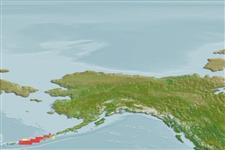>
Perciformes/Cottoidei (Sculpins) >
Liparidae (Snailfishes)
Etymology: Careproctus: Greek, kara = face + Greek, proktos = anus (Ref. 45335); faunus: Named in honor of the Roman god Faunus, the mischievous half-brother of Comus, because of the species' close similarity to C. comus..
Environment: milieu / climate zone / depth range / distribution range
Écologie
marin démersal; profondeur 120 - 422 m (Ref. 72418). Temperate; 58°N - 51°N, 177°W - 165°W (Ref. 72418)
Northeast Pacific: central and eastern Aleutian Islands.
Taille / Poids / Âge
Maturity: Lm ? range ? - ? cm
Max length : 10.2 cm SL mâle / non sexé; (Ref. 72418)
Description synthétique
Clés d'identification | Morphologie | Morphométrie
Rayons mous dorsaux (Total) : 47 - 51; Rayons mous anaux: 41 - 45; Vertèbres: 52 - 56.
Life cycle and mating behavior
Maturities | Reproduction | Spawnings | Egg(s) | Fecundities | Larves
Orr, J.W. and K.P. Maslenikov, 2007. Two new variegated snailfishes of the genus Careproctus (Teleostei: Scorpaeniformes: Liparidae) from the Aleutian Islands, Alaska. Copeia 2007(3):699-710. (Ref. 72418)
Statut dans la liste rouge de l'IUCN (Ref. 130435)
Utilisations par l'homme
Outils
Articles particuliers
Télécharger en XML
Sources Internet
Estimates based on models
Preferred temperature (Ref.
123201): 3.7 - 4.1, mean 3.8 °C (based on 6 cells).
Phylogenetic diversity index (Ref.
82804): PD
50 = 0.5000 [Uniqueness, from 0.5 = low to 2.0 = high].
Bayesian length-weight: a=0.00447 (0.00204 - 0.00980), b=3.17 (2.99 - 3.35), in cm total length, based on LWR estimates for this Genus-body shape (Ref.
93245).
Niveau trophique (Ref.
69278): 3.2 ±0.5 se; based on size and trophs of closest relatives
Résilience (Ref.
120179): Haut, temps minimum de doublement de population inférieur à 15 mois (Preliminary K or Fecundity.).
Fishing Vulnerability (Ref.
59153): Low vulnerability (10 of 100).
